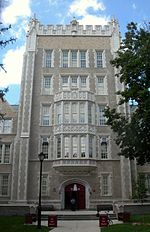Kingsland Homestead
Flushing, QueensHistoric American Buildings Survey in New York CityHistoric house museums in New York CityHistorical society museums in New York CityHouses completed in 1785 ... and 7 more
Houses on the National Register of Historic Places in Queens, New YorkMuseums established in 1973Museums in Queens, New YorkNational Historic Landmarks in New York CityNew York City Designated Landmarks in Queens, New YorkUse American English from June 2022Use mdy dates from June 2022

Kingsland Homestead is an 18th-century house located in Flushing, Queens, New York City. It is the home of the remains of The Weeping Beech, a landmark weeping beech tree, believed to have been planted in 1847. The homestead is also close to the 17th-century Bowne House, the location of the first Quaker meeting place in New Amsterdam. The homestead is operated by the Queens Historical Society, whose quarters are inside; the homestead is open to the public as a museum. The Kingsland Homestead is a member of the Historic House Trust, and is both a New York City designated landmark and a National Register of Historic Places listing.
Excerpt from the Wikipedia article Kingsland Homestead (License: CC BY-SA 3.0, Authors, Images).Kingsland Homestead
37th Avenue, New York Queens County
Geographical coordinates (GPS) Address Website External links Nearby Places Show on map
Geographical coordinates (GPS)
| Latitude | Longitude |
|---|---|
| N 40.763611111111 ° | E -73.824166666667 ° |
Address
Kingsland Homestead
37th Avenue 143-35
11354 New York, Queens County
New York, United States
Open on Google Maps










